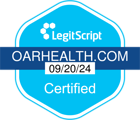One-On-One Coaching Helped Elliot Find Success With TSM

An ask in a closed Facebook group was simple: does anyone need a coach for The Sinclair Method? Little did the person behind the post know that this simple question would provide life-changing support to someone struggling to find a recovery method that worked.
Jodi Green is a Certified Sinclair Method coach at Thrive Alcohol Recovery and Your Sinclair Method Coaching. Like many who begin supporting other people in recovery, Green’s past was colored by alcohol misuse. She drank a bottle of wine a night, often dreading the fight that would ensue with her husband the next day from things she’d said unknowingly when drunk.
Though she was aware of the medication, Jodi never felt comfortable obtaining a naltrexone prescription because she worked in healthcare. One night, she was sipping a drink and scrolled past an assessment from Oar Health. Following the assessment, she saw she could receive a prescription for naltrexone entirely confidentially, and she signed up.
Jodi followed The Sinclair Method (TSM), a framework for taking naltrexone an hour before drinking to diminish cravings for more. With TSM, over time, the brain stops associating alcohol with pleasure. Eventually, someone might lose the desire to drink entirely, a term TSM refers to as extinction. Within three weeks of TSM, Jodi felt the method and medication were a miracle. She knew TSM could help more people and felt inspired to ensure others could access the same tools.
Jodi contacted Katie Lain, a popular TSM coach, intending to help people find the same success she did. After six months, when Jodi hit extinction, she signed up to let go of the shame she carried from her prior secretive drinking days and coach others who might be experiencing the same.
A typical coaching session with Jodi often includes permission to let go of secrecy or embarrassment. Clients typically have not told their families about their problem drinking or that they are seeking help. Jodi wants clients to stop feeling abnormal—the more people talk about alcohol struggles, the less shame they feel, especially when confiding in someone who has been through it before.
A Doctor Prescription Without Context
When you go to the doctor and report problem drinking, they will often advise you to stop or cut back. Though vastly underprescribed, some doctors may even scribble a prescription for naltrexone if a patient presents with alcohol use disorder (AUD). Such is the case for Elliot, who received a prescription and finger-pointing to stop drinking.
Following the doctor’s guidance, Elliot did what he was told, and an alcoholic seizure ensued. The prescription didn’t come with any advice except to take it daily. Elliot continued following the doctor’s instructions and saw no difference. After a couple of months, he stopped taking it altogether and started drinking again.
In his late twenties, Elliot realized he couldn’t control himself with alcohol. Drinking ruled his social life. Like many, Elliot’s alcohol use escalated during the pandemic. He had tried alcoholics anonymous (AA) but felt the attendees were like police instead of friends, offering one way instead of any way that works for recovery.
Elliot’s cultural background doesn’t permit drinking. So when he moved back with his parents during the pandemic, he’d buy vodka to hide the evidence of multiple beer cans. He’d finish multiple bottles per week. His parents eventually found out, and he went to rehab, which didn’t work for him.
One year later, he found Oar Health on Google and read about naltrexone with trepidation—he’d tried it already, and it hadn’t worked.
Enter: A Coach and a New Approach to Naltrexone
While naltrexone was not new to Elliot, TSM was, and his interest was piqued enough to try it. But he wanted more guidance this time. When Elliot saw Jodi’s post on Facebook for free coaching, he jumped at the opportunity.
He quickly learned a few tips on why naltrexone didn’t work for him the first time around—for starters, he needed a higher dose.
Initially, Elliot would tell Jodi that TSM wasn’t working. It felt like nothing was progressing for Elliot until he’d have eureka moments. No stranger to the all-or-nothing feelings that so frequently accompany beginning recovery, she encouraged Elliot to keep a journal logging the drinks he was consuming.
With the written evidence of a daily log, he realized that he was drinking a lot less. He went from five to eight drinks a day to four a week at most. He started taking the pill an hour before drinking instead of daily in the morning and was also given a higher dose, which, with Oar, is easy and includes a few quick questions from a provider.
Throughout the years, Jodi has acquired a toolkit to help coaches navigate TSM.
Jodi’s Tips for Alcohol Moderation
- Keep a log of how many drinks you have per day.
- Nonalcoholic beverages are helpful.
- Compliance is the golden rule.
- You can’t skip the medicine and will set yourself back if you do.
- Take the medication an hour before drinking.
- Alternate drinks from alcohol to water or soda.
- Stretch out the time period you drink a beverage.
- Set what you are drinking out of reach and place a glass of water between you and the drink. You might find you are just thirsty and reaching for the alcohol out of habit!
- Push back the time of day you drink.
- Use any tools to become mindful of how much you are drinking. For example, you can move a hair tie from wrist to wrist for each drink.
- Safely tapering from alcohol can be a game changer and help avoid withdrawal symptoms.
- Change your environment when you are triggered.
- Consider the question: is this a craving or a habit? If it’s a real craving, distract yourself, and if in an hour you still have a strong craving, take naltrexone, wait an hour, and have a drink.
Jodi encourages clients to find rewards other than alcohol. While getting a massage every time you crave a drink might not be practical, any endorphin rush, like a jog around the block, can be helpful.
With growing awareness about his drinking patterns, Elliot discovered that 90% of his drinking felt habitual. As a regular at his neighborhood bar, stopping for a drink was deeply ingrained in his day. Elliot could see the amount of drinks diminishing over time and even hit extinction. A month in, he was ready to try for an alcohol-free day, which was terrifying because of his prior seizure. Jodi reminded him that he had safely tapered way down this time, and his attempt was a success.
He began to notice how much his friends were drinking and realized that TSM was working. He can socialize with friends and sip the same drink for hours instead of leading the next round. He now takes dogs for walks instead of stopping at the bar at 5 pm. The additional money he could have been spending on alcohol, he puts toward staycations. Elliot recently returned from vacation, where he drank more than usual and knew he’d need to taper, which he did. He recognized the signs right away and had Jodi on-call to check in with.
Jodi encourages clients to message her if they have cravings or questions. Mostly, she finds herself responding to the questions, “Can I do this?” “Is this normal?” Most people want two sessions to get the basic info and then want someone to touch base with.
Jodi also has a few long-term clients who were not compliant at first. Many people need TSM guidance because they won't get the same advice from a doctor. Daily naltrexone can be highly effective, but it doesn’t work for everyone—people need more information.
Naltrexone isn’t one size fits all—some people require a higher or lower dosage. If it’s not working, it might not be because the medication is ineffective. Sometimes, people need to take it at a different time of the day. Not all doctors know enough about naltrexone and don’t make the necessary adjustments through follow-up appointments.
Jodi and Elliot now have a friendship beyond coaching. Jodi offers that anyone can try TSM for a week if they are curious. For Elliot, Jodi's recommendations were personalized so that naltrexone worked. Having someone a phone call away made all the difference.
About The Author
Xenia Ellenbogen (she/they) is a journalist specializing in health, mental health, and wellness. Her writing has appeared in publications such as Everyday Health, Well+Good, Rewire News Group, Prism, and more.
Related Articles
- How It Works
- Alcohol & Health
- Alcohol Misuse & Alcohol Use Disorder
- Strategies to Drink Less or Quit
- Treatment Options
- Medication-Assisted Treatment
- Recovery Stories
- Member Stories
- Moderation Stories
- Sobriety Stories
- ¹ Oar Health membership plans include access to the Oar Health platform, virtual consultations with a healthcare professional, and medication if prescribed by a healthcare provider. 3 month membership plan costs $297, equating to $99/mo.
- ² Self-reported by members after 6 months of Oar Health membership.
- ³ Verywell Health survey of Oar Health members, published March, 2023.
- ⁴ Prescription medication is available only if prescribed by a licensed clinician.
- ⁵ Compounded medications are prepared based on a prescription from a healthcare provider. They are not reviewed by the FDA for safety or efficacy.






